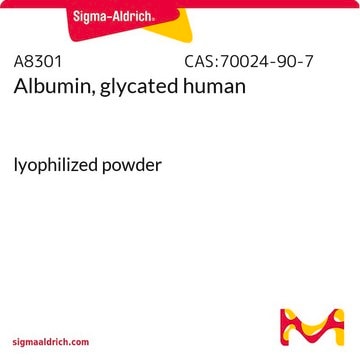The stability of this product in solution has not been evaluated. Generally, peptides should not be stored in solution for extended periods. Should solution storage be necessary, storing aliquots at -20°C is suggested. Note that peptides have a tendency to stick to plastic containers upon storage.
G9145
[Leu15]-Gastrin I human
≥95% (HPLC)
Synonym(s):
[Leu15]-HG-17, LHG-17, [15-Leucine]-Gastrin I, human heptadecapeptide, [18-Pyroglutamic acid, 32-leucine]-Big gastrin I-(18-34)-peptide amide, human, [Leu15]-Gastrin I, human, [Leucine15]-Gastrin I heptadecapeptide, [Leucine15]-Little gastrin I
About This Item
Recommended Products
biological source
human
Quality Level
Assay
≥95% (HPLC)
form
powder
technique(s)
cell culture | mammalian: suitable
UniProt accession no.
storage temp.
−20°C
SMILES string
CC(C)CC(NC(=O)C(Cc1c[nH]c2ccccc12)NC(=O)C3CCCN3C(=O)CNC(=O)C4CCC(=O)N4)C(=O)NC(CCC(O)=O)C(=O)NC(CCC(O)=O)C(=O)NC(CCC(O)=O)C(=O)NC(CCC(O)=O)C(=O)NC(CCC(O)=O)C(=O)NC(C)C(=O)NC(Cc5ccc(O)cc5)C(=O)NCC(=O)NC(Cc6c[nH]c7ccccc67)C(=O)NC(CC(C)C)C(=O)NC(CC(O)=O)C(=O)NC(Cc8ccccc8)C(N)=O
InChI
1S/C98H126N20O31/c1-49(2)38-68(115-96(147)72(43-55-46-101-60-19-12-10-17-58(55)60)117-98(149)74-20-13-37-118(74)77(122)48-103-86(137)61-25-31-75(120)105-61)93(144)111-66(30-36-82(131)132)92(143)110-65(29-35-81(129)130)91(142)109-64(28-34-80(127)128)90(141)108-63(27-33-79(125)126)89(140)107-62(26-32-78(123)124)88(139)104-51(5)85(136)113-70(41-53-21-23-56(119)24-22-53)87(138)102-47-76(121)106-71(42-54-45-100-59-18-11-9-16-57(54)59)95(146)114-69(39-50(3)4)94(145)116-73(44-83(133)134)97(148)112-67(84(99)135)40-52-14-7-6-8-15-52/h6-12,14-19,21-24,45-46,49-51,61-74,100-101,119H,13,20,25-44,47-48H2,1-5H3,(H2,99,135)(H,102,138)(H,103,137)(H,104,139)(H,105,120)(H,106,121)(H,107,140)(H,108,141)(H,109,142)(H,110,143)(H,111,144)(H,112,148)(H,113,136)(H,114,146)(H,115,147)(H,116,145)(H,117,149)(H,123,124)(H,125,126)(H,127,128)(H,129,130)(H,131,132)(H,133,134)
InChI key
CMVMLPDUAGUTOC-UHFFFAOYSA-N
Gene Information
human ... GAST(2520)
Looking for similar products? Visit Product Comparison Guide
Amino Acid Sequence
General description
Application
Biochem/physiol Actions
Other Notes
Storage Class Code
11 - Combustible Solids
WGK
WGK 3
Flash Point(F)
Not applicable
Flash Point(C)
Not applicable
Personal Protective Equipment
Choose from one of the most recent versions:
Certificates of Analysis (COA)
Don't see the Right Version?
If you require a particular version, you can look up a specific certificate by the Lot or Batch number.
Already Own This Product?
Find documentation for the products that you have recently purchased in the Document Library.
Customers Also Viewed
Articles
Human pancreatic cancer organoid biobank (PDAC organoids) with various KRAS mutations to aide in 3D cell culture and cancer research applications.
Human pancreatic cancer organoid biobank (PDAC organoids) with various KRAS mutations to aide in 3D cell culture and cancer research applications.
Human pancreatic cancer organoid biobank (PDAC organoids) with various KRAS mutations to aide in 3D cell culture and cancer research applications.
Human pancreatic cancer organoid biobank (PDAC organoids) with various KRAS mutations to aide in 3D cell culture and cancer research applications.
-
After preparing aliquots, what is the stability of this product at -20?
1 answer-
Helpful?
-
-
Is this product also suitable for use with other mammalian species, such as mouse, for ex vivo tissue studies, as opposed to just human organoid culture medium?
1 answer-
The product's validation for batch release does not currently cover murine ex vivo tissue testing. However, the following citations may provide insights into its application for ex vivo non-human samples:
Sci Adv. 2023 Nov 17;9(46):eadh0322. Title: Inactivation of the tumor suppressor gene Apc synergizes with H. pylori to induce DNA damage in murine gastric stem and progenitor cells PMID: 37967175
Infect Immun. 2016 Sep 19;84(10):3083-91. Title: Intestinal Enteroids Model Guanylate Cyclase C-Dependent Secretion Induced by Heat-Stable Enterotoxins PMID: 27481254
Helpful?
-
-
I am interested in this product. A colleague uses it for human organoid culture medium. However, I work with murine ex vivo tissues. Is this also applicable for other mammalian species (so mouse in stead of human)?
1 answer-
This product has not been tested for use with murine ex vivo tissue. However, the following citations may be of interest for its application in ex vivo non-human samples.
Sci Adv. 2023 Nov 17;9(46):eadh0322.
Inactivation of the tumor suppressor gene Apc synergizes with H. pylori to induce DNA damage in murine gastric stem and progenitor cells
PMID: 37967175
https://pubmed.ncbi.nlm.nih.gov/37967175/Infect Immun. 2016 Sep 19;84(10):3083-91.
Intestinal Enteroids Model Guanylate Cyclase C-Dependent Secretion Induced by Heat-Stable Enterotoxins
PMID: 27481254
https://pubmed.ncbi.nlm.nih.gov/27481254/Helpful?
-
-
この製品の溶媒は何を用いればよろしいでしょうか。水またはPBS(-)には溶けますでしょうか、あるいはDMSOでしょうか。
1 answer-
This product is tested for solubility at 1mg/ml in 0.1% NaOH or 1% NH4OH. Other solvents have not been evaluated.
Helpful?
-
Active Filters
Our team of scientists has experience in all areas of research including Life Science, Material Science, Chemical Synthesis, Chromatography, Analytical and many others.
Contact Technical Service








![[Leu15,Gly18]-Gastrin2-17](/deepweb/assets/sigmaaldrich/product/images/384/185/d3095ca6-fe9a-4e1c-b2e9-29ad2bd40c46/640/d3095ca6-fe9a-4e1c-b2e9-29ad2bd40c46.jpg)
![[Gly18]-Gastrin 1-17 human](/deepweb/assets/sigmaaldrich/product/images/973/112/79e0734e-033a-4a31-9368-b08610cdcfd1/640/79e0734e-033a-4a31-9368-b08610cdcfd1.jpg)




